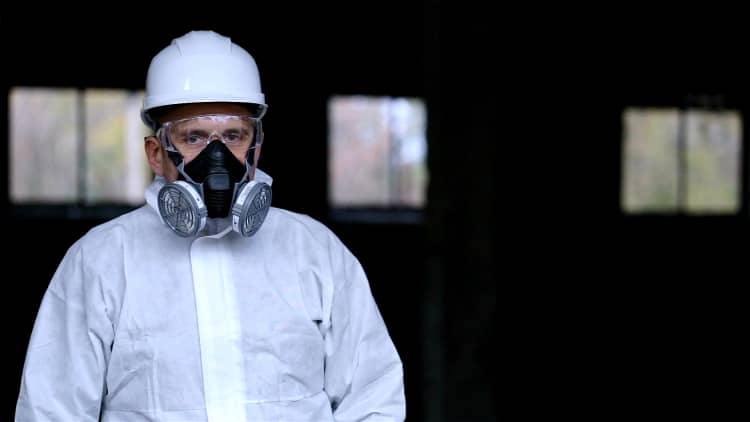If we entertain the conjecture that this disease was deliberately distributed, then the agents went out sometime in October to target public transportation systems anywhere. An infected agent would simply ride the trains and move seats often in order to make a train live.
After doing that infected individuals will do the rest while mostly fending off the disease itself as a nasty cold. From that we soon have Stockholms thirty percent penetration.
It also means that when our testing does catch up we are going to find this is true everywhere. This really then begs the issues of social separation unless repeated exposure is a serious risk that cannot be contained otherwise.
Doctor who treated first US coronavirus patient says COVID-19 has been ‘circulating unchecked’ for weeks
PUBLISHED FRI, MAR 6 202011:04
Since the first U.S. COVID-19 patient landed at Seattle-Tacoma International Airport on Jan. 15, the virus has spread to at least 75 people in Washington state.
The number of confirmed cases in the U.S. has risen to 233 across at least 17 states as of Friday morning.
Worldwide, more than 100,600 infections have been confirmed, according to Johns Hopkins University.
Global coronavirus cases now exceed 135,000—Four experts on what happens next
Dr. Amy Compton-Phillips recalled the day the first U.S. patient infected with COVID-19, a 35-year-old man from Snohomish County in Washington state, had taken a “turn for the worse.”
“He was day nine in his course and he actually started going downhill, started getting worse,” said Compton-Phillips, chief clinical officer of Providence St. Joseph Health, where the patient was treated.
At first, the patient only had common cold-like symptoms, Compton-Phillips said. But very quickly he began to have shortness of breath and a cough, she said. His X-ray also showed viral pneumonia. He needed supplemental oxygen and had to be put on an experimental antiviral treatment.
The patient has recovered and has been released from the hospital.
Since the patient landed at Seattle-Tacoma International Airport on Jan. 15 from the outbreak’s epicenter in Wuhan, China, the virus has spread to at least 75 other people in Washington state, killing 14 in the U.S. so far — 13 in Washington and one in California, according to Johns Hopkins University.

Dr. Satish Pillai, deputy director for the Division of Preparedness and Emerging Infections at the US Centers for Disease Control and Prevention, speaks during a press conference about the first confirmed U.S. case of a virus known as the 2019 novel coronavirus at the state Public Health Laboratories on January 21, 2020 in Shoreline, Washington. The patient diagnosed with the virus, also known as the Wuhan coronavirus, is recovering in isolation at Providence Regional Medical Center Everett in Everett, Washington.
David Ryder | Getty Images
Life Care Center
At least five of those deaths have been traced to a skilled nursing facility, Life Care Center, in Kirkland, according to Washington state and local health officials. On Saturday, county health officials said about 50 residents and employees of the nursing care facility in the Seattle suburb were ill with “respiratory symptoms or hospitalized with pneumonia or other respiratory conditions of unknown cause” and were being tested for COVID-19.
Public health officials have identified at least 233 cases in the U.S. so, a fraction of the more than 100,600 infections across the world. But epidemiologists and state officials say the actual number of COVID-19 patients in the U.S. is likely in the thousands, maybe even tens of thousands, since testing here has been limited by a lack of kits and stringent criteria set by the Centers for Disease Control and Prevention.
Compton-Phillips said the doctors, nurses and other front-line workers watching the outbreak in real time are all saying “this is coming.”
“It’s not if, it’s when. And we better get ready now,” she said.

Definitely making progress on testing capacity, but we have a lot more to screen
Global spread
World health officials are turning their attention abroad and away from China, where businesses have started reopening operations and the growth in COVID-19 cases have slowed over the last two weeks. Last week, WHO increased its risk assessment of the coronavirus to “very high” at a global level — its highest warning.
Outside China, 14,768 cases across at least 74 countries had been confirmed as of Thursday morning — up from 282 cases in four countries on Jan. 21, according to the World Health Organization.
“We are on the highest level of alert or highest level of risk assessment in terms of spread and in terms of impact,” Dr. Mike Ryan, executive director of WHO’s health emergencies program, said during a press briefing on Feb. 28. “This is a reality check for every government on the planet: Wake up. Get ready. This virus may be on its way and you need to be ready. You have a duty to your citizens, you have a duty to the world to be ready.”
Compton-Phillips said some front-line workers had been saying “if” when talking about the virus becoming widespread in the U.S. — until two weeks ago, when cases suddenly cropped up in Iran and Italy with no known connection to China.
Then, “we started saying, ‘when,’” she said.
The health system will need to think where it can source essential products such as gowns, masks and gloves, Compton-Phillips said. She said they’ve started putting masks for patients “behind the counter,” to help conserve them.
“The boxes of masks were walking away,” she said.
WHO officials said panic buying and hoarding medical supplies is putting lives at risk and causing a “severe and mounting disruption” to the world’s stockpile of protective gear. “Shortages are leaving doctors, nurses and other front-line workers dangerously ill-equipped to care for COVID-19 patients, due to limited access to supplies such as gloves, medical masks, respirators, goggles, face shields, gowns, and aprons,” WHO said in a statement Tuesday.

‘Toehold’ in the US
When that first patient in Washington state presented himself for testing, Compton-Phillips said the hospital took an “overkill” approach.
“We will presume it’s COVID-19 until proven otherwise, so we’ll put a mask on them and put them in an isolation room,” she said. She added that when transporting that first patient to an appropriate isolation room, “we had him in this special gurney with plastic around it, so he wouldn’t contaminate anything.”
But that was over a month ago. Since then, the number of confirmed cases in the U.S. has risen to 233 across at least 17 states as of Friday morning, according to Johns Hopkins’ data. For weeks, most of the U.S. cases could be traced to travel in Wuhan, the Diamond Princess cruise ship, which was quarantined off the coast of Japan, or close contact with those people.
That’s all changed since last weekend. There are now well over two dozen cases in the U.S. of person-to-spread, many of which are proving to have been transmitted openly in the community, and it appears to be getting worse, according to state health officials.
State and local health have confirmed community transmission cases in California, Washington state, New York and North Carolina — where a woman contracted the virus on a trip to Washington state in what appears to be the nation’s first domestic travel-related infection.
Circulating unchecked
Part of the problem, Compton-Phillips said, was the CDC’s delay in getting testing kits to local health agencies and its reluctance to test patients who hadn’t traveled to Wuhan, China.
“We had real challenges initially. ... I think it’s one of the reasons we’re seeing these hot spots pop up around the country is because we simply didn’t know this had already hit our shores,” she told CNBC, adding that cases will rise as testing is expanded and labs discover new cases that were previously hidden. “I do think that this virus has been circulating now for several weeks in the U.S. ... Until now, it’s been circulating unchecked.”
Some hospitals still haven’t instituted strict isolation protocols for everyone being tested, and some state officials are even starting to relax hospital quarantine rules for patients who test positive. One woman in New York is under self-quarantine at her home in Manhattan. State health officials said a California patient was not under quarantine as doctors appealed to the CDC to test her. Since she hadn’t been to Wuhan, or been in contact with anyone who was, she was out and about in her community.
One patient in New Hampshire under self-quarantine broke protocol by attending a private event Friday night, state officials said Tuesday. In Texas, the CDC mistakenly released a Prince Cruise passenger who was under mandatory quarantine who later tested positive for the virus.
Testing delays
Last week, California Gov. Gavin Newsom said the state was monitoring more than 8,400 people for the coronavirus. As the magnitude of the emerging virus grew in the U.S., federal officials have loosened guidelines that restricted local clinicians from testing patients and led to delays.
The CDC sent test kits earlier in the outbreak to public health labs around the country, but those kits were problematic, CDC officials have since said, and potentially inaccurate. Because local clinicians can’t depend on the test kits, some have had to ship samples to a laboratory with the ability to run the tests, like the CDC laboratory in Atlanta.
“Some of our tests are getting sent to CDC in Atlanta, and it’s taking a while to get them back,” Compton-Phillips said. “The first couple [of] patients it was only taking a day or two. And now it seems to be taking about a week to get the test results back.”
Those delays, Compton-Phillips said, means doctors and nurses need to treat patients as if they have the virus until the results come back, which can be taxing for patients and health-care providers alike.
On Feb. 28, however, Dr. Nancy Messonnier, director of the CDC’s National Center for Immunization and Respiratory Diseases, announced that the agency is rolling out new tests. She said the move will improve the country’s ability to quickly identify and treat COVID-19 patients. Private labs Quest Diagnostics and Lab Corp. will be able to test specimens next week.
“Our goal is to have every state and local health department online, doing their own testing,” she said.
Correction: This article was updated to correct the number of cases reported by WHO on Jan. 21 to 282 in four countries.

No comments:
Post a Comment